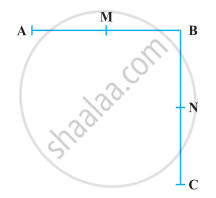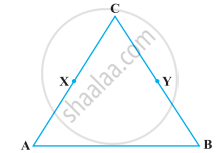Advertisements
Advertisements
प्रश्न
In the following figure AB = BC, M is the mid-point of AB and N is the mid-point of BC. Show that AM = NC.

उत्तर
Given, AB = BC ...(i)
M is the mid-point of AB.
∴ AM = MB = `1/2` AB ...(ii)
And N is the mid-point of BC.
∴ BN = NC = `1/2` BC ...(iii)
According to Euclid’s axiom, things which are halves of the same things are equal to one another.
From equation (i), AB = BC
On multiplying both sides by `1/2`, we get
`1/2` AB = `1/2` BC
⇒ AM = NC ...[Using equations (ii) and (iii)]
APPEARS IN
संबंधित प्रश्न
Give a definition of the following term. Are there other terms that need to be defined first? What are they, and how might you define them?
radius of a circle
The three steps from solids to points are ______.
Boundaries of solids are ______.
Solve the following question using appropriate Euclid’s axiom:
Two salesmen make equal sales during the month of August. In September, each salesman doubles his sale of the month of August. Compare their sales in September.
Solve the following question using appropriate Euclid’s axiom:
In the following figure, we have X and Y are the mid-points of AC and BC and AX = CY. Show that AC = BC.

Solve the following question using appropriate Euclid’s axiom:
In the following figure, we have ∠1 = ∠2, ∠2 = ∠3. Show that ∠1 = ∠3.

In the following figure BM = BN, M is the mid-point of AB and N is the mid-point of BC. Show that AB = BC.

Read the following statements which are taken as axioms:
- If a transversal intersects two parallel lines, then corresponding angles are not necessarily equal.
- If a transversal intersect two parallel lines, then alternate interior angles are equal.
Is this system of axioms consistent? Justify your answer.
The following statement is true or false? Give reason for your answer.
There are an infinite number of lines which pass through two distinct points.
The following statement is true or false? Give reason for your answer.
In the following figure, if AB = PQ and PQ = XY, then AB = XY.

